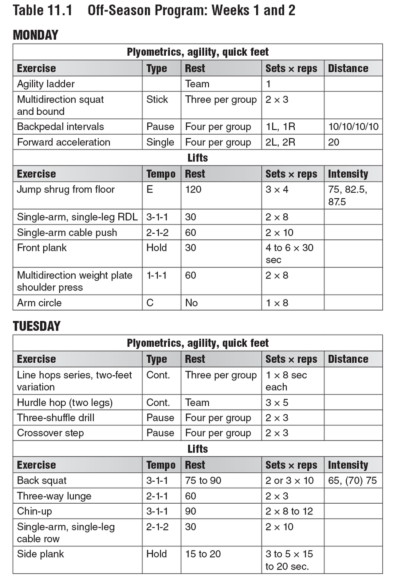Exercise Distribution Within a Training Week
This is an excerpt from Complete Conditioning for Volleyball by Steve Oldenburg.
The four-day program outlined here (tables 11.1 to 11.6) has training days on Monday, Tuesday, Thursday, and Friday. Exercises must be distributed appropriately throughout the week to achieve maximal performance, promote recovery, and reduce the incidence of overuse injuries because training is performed on back-to-back days twice during the week.
Lifting is divided into hip, chest, and shoulder - dominant exercises on Monday and Thursday and quad and back - dominant movements on Tuesday and Friday. This division of movements and muscle groups diminishes the negative or fatigue effect of back-to-back lifts.
Abdominal training is broken up, alternating the emphasis between front abs (rectus abdominis) and lateral abs (obliques) on back-to-back days. This format allows adequate recovery from day to day making it possible to train the abs every day.
In the early stages of plyometrics, drills can be broken down into vertical and horizontal or lateral movements (jumping versus bounding). These changes in movement patterns place different stresses and sheer forces on the joints, connective tissues, and muscles. The small variations in movement patterns and joint angles help with recovery from session to session.
In the early stages of acceleration, agility and reaction training movements can be broken down into sagittal and lateral movements. The sagittal plane relates to forward sprinting, pivoting and sprinting, and backpedaling. The lateral plane relates to side-to-side sprinting, cutting, and shuffling by separating the exercises performed on back-to-back workout days by the planes of movement, different movement patterns, joint angles, and joint sheer forces are placed upon the body, which promotes recovery from session to session.
Prior to undertaking a workout, athletes should perform a proper dynamic warm-up as well as any needed individual mobilizations so they can perform workout movements properly. Conditioning (table 11.7) should be performed postlifting on Tuesday and Friday to maximize the strength and power benefits of the exercise program. This allows for one or two days for the athlete to recover before the next workout session.
To maximize recovery, myofascial release techniques, mobilizations, stretching, or yoga should be performed on Wednesday and Saturday or Sunday.


SHOP

Get the latest insights with regular newsletters, plus periodic product information and special insider offers.
JOIN NOW


